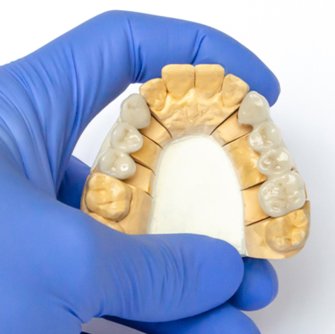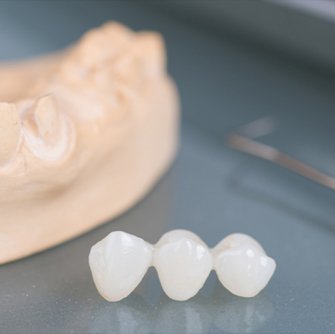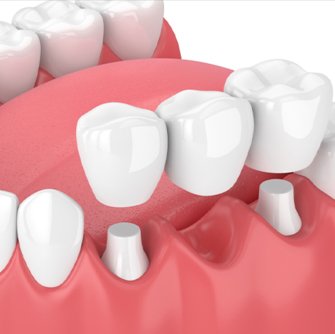
Dental Bridges Overview
A dental bridge is a fixed dental prosthesis used to replace one or several missing teeth by permanently joining an artificial tooth to adjacent teeth or dental implants.
Who is this for
- Patients looking to restore the appearance and function of their dentures.
- Good candidates are those who have strong healthy teeth on either side of the tooth gap.
- Patients with compromised teeth due to gum disease
- Individuals with reduced bone density who cannot undergo a bone grafting procedure
Treatment abroad
- Minimum stay: 4 - 5 Days
- Number of trips: 1
Treatment process
- Your preperation for denture will take average 2 hours.
- The dentist will prepare your custom-made crowns, which may take average 5 days. Once ready, crowns will be placed in 2 hours.
- Any minor pain caused by the insertion of the bridge should subside in a few days.
Dental Bridge Treatment Cost
Bridge Type
Advantages
Disadvantages
Price
Zirconia Bridge
Per Unit
Durable
Long lasting
Well tolerated by the human body
Aesthetic Looking
Price
€160
Ceramic-Metal Bridge
Per Unit
Durable
Price
Not as natural-looking as other options
€120
Dental Bridge Treatment Cost
Bridge Type
Price
Zirconia Bridge
Per Unit
€160
Ceramic-Metal Bridge
Per Unit
€120
Dental Bridge Treatment Process
What Is a Dental Bridge?
A dental bridge is a false tooth, that is held in place by anchoring it to the surrounding teeth. The bridge is specially shaped to fit your mouth and the anchoring teeth will need to be recontoured to hold the bridge in place effectively.
How Do Dental Bridges Procedures Work?
Consultation
During your initial consultation your dentist will assess your suitability for dental bridge surgery. Good candidates for dental bridges are patients with healthy teeth surrounding the gap. If your dentist detects any underlying conditions with the surrounding teeth that may develop in the coming years, they may recommend a dental implant instead, as this form of dental procedure is not reliant on the presence of strong abutment teeth. You dentist need to take an X-ray to get a proper sense of which one is ideal for you.
Anaesthesia
Your dentist will use a local anesthetic while recontouring the abutment teeth to hold the crowns that will hold the bridge in place. The final procedure, where the bridge is cemented in place, is usually painless but your dentist may opt for the use of a local anesthetic again to ensure a comfortable experience.
Reshape the teeth next to the gap
- In the first part, your doctor will file and reshape the teeth next to the gap that is to be filled to make them suitable for holding the bridge in place. The dentist will then make an impression of the newly shaped area and send it to a lab so that a bespoke pontic can be created for you.
- Your dentist may then create a temporary bridge or filling. This is mostly done for aesthetic reasons but also to provide protection for the reshaped teeth before the permanent teeth are cemented into place.
Custom-made crown placement
Once the dental bridge comes back from the lab, your dentist will arrange another appointment for you. At this session, the temporary filling will be removed and the area underneath thoroughly cleaned. The dentist may employ the use of a local anesthetic before applying dental cement and permanently fixing the new bridge into position.
What Should I Expect?
The loss of a tooth or several teeth can have a strong impact on individuals, particularly when located in an especially visible spot. Bridges can be a great way to restore your confidence and your eating and speaking functions. However, each one comes with its own requirements and commitments and you should aim to balance your desire for a fast outcome with the benefits of a long-term strategy. You should spend time with your dentist going through all the available options before making a decision.
A successful dental bridge procedure will offer a number of benefits including the restoration of your smile and the shape of your face as well as the ability to chew and speak as you did before.
DENTAL BRIDGE GALLERY
Dental bridge process images
Dental Bridges Treatment Aftercare
How to care for a dental bridge?
If your mouth feels a little sensitive in the first few days after your appointment, don't worry. Soon you won't even notice your bridge! In the meantime, you might feel most comfortable avoiding hot and cold foods and switching to a toothpaste designed for sensitive teeth for a little while.
The areas around bridges are common places for gum disease and tooth decay, so good oral care is extremely important. If cared for properly, a bridge will last permanently. Follow your dentist's instructions for brushing and flossing around your bridge.
Here's a quick checklist for your dental bridge care:
- Brush twice a day with a soft toothbrush and fluoride toothpaste
- Floss daily between your teeth and under the bridge, according to your dentist's directions
- Ask your dentist if they recommend using a mouthwash as an added protection against gum disease and tooth decay
- Schedule your regular cleaning and dental exam at least twice a year
- Talk to your dentist if you notice any change or discomfort
Dental Bridges FAQ
What are the advantages of this procedure?
A dental bridge can:
- Help your bite.
- Prevent remaining teeth from moving out of place.
- Restore your ability to chew and speak.
- Restore your smile.
How long do dental bridges last?
Dental bridges can last at least five to seven years. With good oral hygiene and regular professional cleanings, the bridge may last more than 10 years.
Is it hard to eat with a dental bridge?
People often find the opposite is true, replacing the missing teeth makes it easier to eat. You may prefer to eat soft foods cut into small pieces until you get used to the bridge.
Will the dental bridge change how I speak?
If you are missing front teeth, it can be hard to speak clearly. A dental bridge with front teeth in the right place can improve your speech.
Potential Risks & Side Effects
- Infection
- Increased risk of decay in the abutment teeth
Alternative treatments
Plan your treatment and get a quote online.
30 minutes free online video and phone consultation. Schedule your virtual visit.









